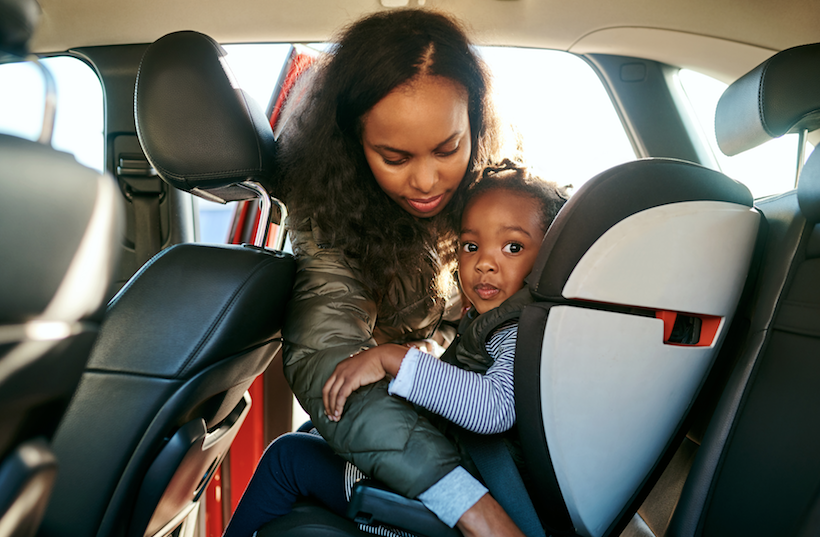Having a baby is a milestone moment, a life-changing experience that brings new responsibilities. For many moms-to-be, the days and weeks before they give birth are filled with preparations for the arrival of their newest family member. From cots and clothes, to bottles and bibs, there is a dazzling array of baby gear to consider and many decisions to be made.
While it may seem that baby’s first car trip isn’t as much of a priority before the child is born, if you are planning to drive your newborn baby anywhere in your car, then you will need to consider buying a car seat as soon as possible.
What the law says
In South Africa, the National Road Traffic act stipulates that:
- Car seats for babies and young children under the age of 3 are compulsory. It is illegal to transport a child under the age of 3 in a vehicle if they are not strapped into a car seat and the car seat used must meet a minimum prescribed SABS standard.
- Any child between the ages of 3 and 14 must be wearing a car seat when the vehicle is in operation failing, which the driver of the vehicle will be held liable.
Experts also strongly recommend that children under the age of 12, or under a height of 1.5m must be supported in a booster seat while travelling in a car to limit injury.
According to the Automobile Association of South Africa (AA):
- Car seats and boosters for infants and children should be placed on the vehicle’s back seat.
- Children under the age of 2 should be strapped into a rear-facing car seat and moved only to a front-facing car seat as they get older.
The AA also has a useful feature on its website where you can check the safety ratings of the car seat you are considering buying for your baby.
Why car seats for children are so important
Last year, the Road Traffic Management Corporation revealed that road traffic collisions are a leading cause of death and injuries for children under the age of 14 in South Africa and that in 2019, child deaths constituted 8% of the total number of road traffic fatalities in the country. And according to the American Academy of Paediatrics, in children younger than 1 year, using car seats decreases mortality by 71%.
Leading emergency medical service Netcare 911 also highlights that “infants are especially at risk for head and spinal cord injuries because their bones and ligaments are still developing. Their heads are also proportionately larger than their necks as opposed to adults, so their structural support system is still a little wobbly.
There are two types of infant car seats, each with specific requirements for proper installation. When choosing your seat, remember that your baby’s head and neck are most at risk, although it also doesn’t take much to cause injury to any other part of the infant’s body.”
Tips for using and choosing a car seat
- Read the user manual carefully and follow the manufacturer’s instructions on how to install the car seat. If you can, it may be wise to consider having the car seat professionally installed. Any fault in the installation could render the car seat unsafe.
- It is preferable to not use a second-hand car seat unless you are sure that the seat is still properly operational and has been certified as safe for use by a reputable organisation. A second-hand car seat may look okay but you may not be able to see the damage that would render the seat unsafe. Wherever possible, buy a new car seat from a specialty baby shop where you can be given good advice and assistance.
- There are many different types of car seats for infants and booster seats for children, so ensure that you are getting the right seat for your baby/child’s specific requirement such as age, height, and weight. While it may seem like an expensive exercise, it is a vital and necessary cost to ensure the safety of your child.
- Car seats should not be used in any space outside of a car as they may be unstable, may fall over and may result in injury. Car seats are designed and engineered to work within a car environment only. When the car seat is being used in the car, ensure that all the harness straps are secure and fit your child snugly and that the car seat is properly tethered. Remove any bulky clothing that may impact how snugly your child is secured.
- It is advised that a baby stays no longer than two hours in a car seat and that long car trips are broken up with regular stops where the baby or child can be taken out of the car seat and allowed to stretch out.
- Never place a rear-facing car seat in front of an active passenger airbag. This can pose a grave threat to an infant. Disable or deactivate these airbags if this is the only place you can put the car seat.
- Best practice internationally is that a car seat should be placed on the backseat of the vehicle, where it is visible to the driver in the rear-view mirror.
Conclusion
Car seats are a positive and necessary investment to ensure the safety of your little one. In South Africa, organisations and initiatives such as Precious Cargo and #carseatfullstop aim to inform and educate. However, as the technology improves, and laws change, it is imperative that parents and any other individuals driving infants and children do their research and due diligence to keep themselves updated on child car safety best practices.
Brought to you by First For Women Vehicle Insurance.
Disclaimer: This content is for informational, educational, or entertainment purposes only. We do not make any warranties about the completeness, reliability, and accuracy of the content.
Feature Image: Katleho Seisa/Getty

